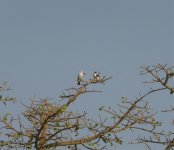Bokmakierie99
Well-known member
I took a little birding trip through some of southwestern Zambia between September 1st and the 11th, beginning in Livingstone and ending in Lusaka.
I thought I'd write up a trip report as it isn't the most widely-birded destination but certainly has a lot to offer.
Basic Itenerary:
Sept 1: Arrival, relaxation at lodge near Livingstone
Sept 2: Viewing falls and birding on the Zambian side of Victoria Falls.
Sept 3: Zambezi National Park and Zimbabwe side of Vic Falls.
Sept 4: Drive to Choma (no birding)
Sept 5: Nkanga River Conservation Area (Chaplin's Barbet), then drive to Kafue NP
Sept 6-11: Kafue NP: Nanzhila Plains, Kasabushi Camp, McBride's Camp
Books:
Unfortunately there's not yet a bird book for Zambia. We used the Southern Africa book ("Sasol" in ZA) in conjunction with our East African book (Princeton FG, Stevenson + Fanshawe). In retrospect, though, I wish I'd gone with the Birds of Africa South of the Sahara, which has illustrations and maps for every species in the country.
"A Guide to the IBAs of Zambia" is a very interesting read, and a book I'd recommend if you're interested in the country's ornithology.
Day 1:
We flew in to Livingstone from Johannesburg on SAA... we were lucky to be on the right side of the plane to see the falls as we descended.
Having gotten up at 3 that morning for the flights in, we virtually no birding our first day, instead just getting a taxi to our lodge, the Maramba River Lodge, outside Livingstone.
It's a bit more rustic than we'd expected given the cost... but it grows on us during our three nights there. The restaurant and bar have views over the Maramba River, where hippos are almost always lounging, and occasional elephants come to drink.
In the late afternoon we take a little walk around the grounds of the lodge. Not a whole lot is about, but we do find a mixed flock containing Yellow-breasted Apalises, Black-backed Puffbacks, and Southern Black Tits. As the sun sets, we watch Squacco Herons and African Jacanas among the lily pads on the river.
I thought I'd write up a trip report as it isn't the most widely-birded destination but certainly has a lot to offer.
Basic Itenerary:
Sept 1: Arrival, relaxation at lodge near Livingstone
Sept 2: Viewing falls and birding on the Zambian side of Victoria Falls.
Sept 3: Zambezi National Park and Zimbabwe side of Vic Falls.
Sept 4: Drive to Choma (no birding)
Sept 5: Nkanga River Conservation Area (Chaplin's Barbet), then drive to Kafue NP
Sept 6-11: Kafue NP: Nanzhila Plains, Kasabushi Camp, McBride's Camp
Books:
Unfortunately there's not yet a bird book for Zambia. We used the Southern Africa book ("Sasol" in ZA) in conjunction with our East African book (Princeton FG, Stevenson + Fanshawe). In retrospect, though, I wish I'd gone with the Birds of Africa South of the Sahara, which has illustrations and maps for every species in the country.
"A Guide to the IBAs of Zambia" is a very interesting read, and a book I'd recommend if you're interested in the country's ornithology.
Day 1:
We flew in to Livingstone from Johannesburg on SAA... we were lucky to be on the right side of the plane to see the falls as we descended.
Having gotten up at 3 that morning for the flights in, we virtually no birding our first day, instead just getting a taxi to our lodge, the Maramba River Lodge, outside Livingstone.
It's a bit more rustic than we'd expected given the cost... but it grows on us during our three nights there. The restaurant and bar have views over the Maramba River, where hippos are almost always lounging, and occasional elephants come to drink.
In the late afternoon we take a little walk around the grounds of the lodge. Not a whole lot is about, but we do find a mixed flock containing Yellow-breasted Apalises, Black-backed Puffbacks, and Southern Black Tits. As the sun sets, we watch Squacco Herons and African Jacanas among the lily pads on the river.





